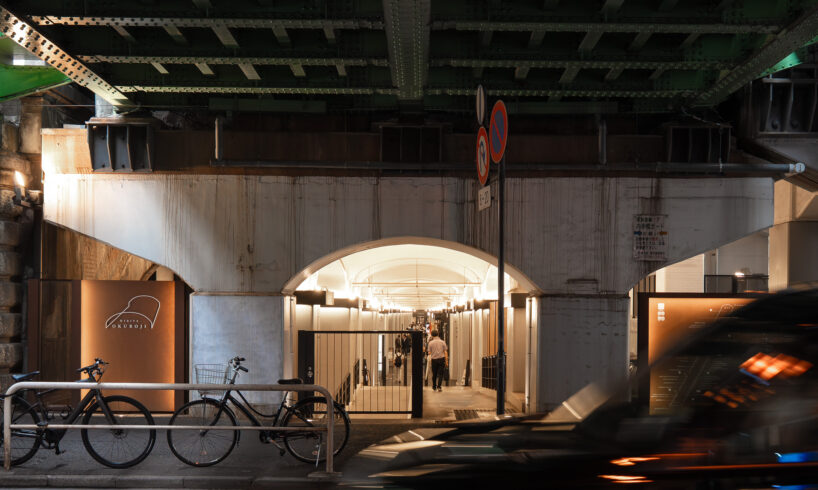
From October 18 to November 30, Hibiya Okuroji will be hosting a special campaign for Tokyo Weekender readers — show this article at check-out to receive a discount coupon (no purchase necessary). For more information, see here.
Running for nearly 300 meters beneath historic railway arches, Hibiya Okuroji isn’t your typical shopping and dining complex. Trains rumble overhead, adding to the unique atmosphere, while below the tracks a different world unfolds: Dozens of stylish restaurants, boutiques and bars are tucked into the space’s graceful redbrick arches, which were first built in 1910 under the guidance of German engineers.
The space takes its name from its location “in the back” (oku) of Hibiya and Ginza and from the word for alleyway (“roji”). Walking through Okuroji, you get the feeling of stepping into a secret corridor of the city. The preserved brick structure lends a sense of heritage, while the carefully chosen shops and restaurants give the space a curated, cosmopolitan feel.
Whether you come for a world-famous pastry, a bespoke cocktail, regional Japanese cuisine or traditional crafts, each stop along Okuroji’s vaulted passage adds to the sense of discovery — a cultural stroll hidden in plain sight, just under the tracks. Read on for a sampling of the shops, eateries and experiences you can find here.
Patisserie TEN&: World-Famous Cream Puffs and Other Elegant Delicacies
For those with a taste for finely crafted desserts, Patisserie TEN& is a must-visit; it’s often said to make the best cream puff in all of Tokyo. (These abundantly-filled delicacies are, unsurprisingly, a big hit on social media.) In both its refined, Art Deco-inspired decor and its menu offerings, the space strikes a careful balance between Japanese subtlety and French technique.
The signature cream puffs — available in chocolate, vanilla and seasonal flavors, including matcha — are filled right in front of you, ensuring freshness and maintaining the perfect crispiness of the outer layer. Watching the chef at work is another great part of the experience.
Beyond its famous cream puffs, the patisserie offers a variety of finely crafted desserts that are also well worth trying — including a signature parfait with a layer of pudding that’s crowned with a handmade canelé (also assembled before your eyes).
Folklore mixology&terroir: Inventive, Meticulously Crafted Cocktails Rooted in Japan
Japan’s cocktail bars are renowned for their precision, inventiveness and service, and Folklore mixology&terroir stands out even among the best. Part of the acclaimed Mixology Group, which is known for pushing boundaries across Tokyo, the bar specializes in Japanese spirits. It transforms sake, shochu and awamori into avant-garde — and undeniably delicious — cocktails. Each drink is an exploration of Japanese culture, rooted in the traditions and terroir of the region where its ingredients were crafted.
The cocktails themselves are wildly inventive, often featuring house-made liqueurs and unusual flavor combinations. The Flying Fish Sour, for example, blends brown sugar shochu, bonito-flake infused vodka, yuzu pepper, shiso leaf and egg white into a layered, sophisticated drink that delights the palate.
For those overwhelmed by the menu, the bar offers a cocktail omakase course. Affordable and expertly guided, it’s a perfect introduction to the Folklore concept and to Japan’s rich tradition of spirits in general.
Mizuno Dye Factory: A Rare Chance to Try Your Hand at Indigo Dyeing
Mizuno Dye Factory offers a rare chance to try traditional Japanese indigo dyeing, or aizome, in a hands-on workshop. Founded in 1907 in Hokkaido, the studio brings over a century of expertise to Tokyo, preserving techniques passed down through generations.
Workshops run on weekends, with weekday sessions available by appointment. You can choose from items provided in the studio — T-shirts, cloth bags or tenugui towels — or bring your own cotton, linen, silk or rayon piece. Each fabric is carefully dipped into the indigo vat, left to oxidize, and dipped again until it reaches a deep, vibrant blue. Or you can opt to try traditional shibori techniques, similar to tie-dyeing, which let you create dazzling and intricate patterns.
If hands-on dyeing isn’t your style, the studio also offers a curated selection of finished items for sale. Each piece is made in-house using traditional methods and natural ingredients.
Sumiyaki Unafuji Yurakucho: Premium Eel in a Refined Setting
Sumiyaki Unafuji Yurakucho serves expertly grilled eel in a setting that balances modern elegance with traditional Japanese aesthetics. It’s a sister restaurant of the renowned Nagoya restaurant Sumiyaki Unafuji, which has been recognized in the Michelin Guide for its precise technique and high-quality ingredients.
The specialty here is hitsumabushi, a style of serving grilled eel over rice. At Unafuji, the eel is cooked using the jiyaki method, grilled directly over high-temperature charcoal without steaming, giving it a crisp, caramelized exterior while keeping the interior tender and juicy. Each dish uses premium blue eel, prized for its size and texture, which adds a naturally rich, sweet flavor to every bite.
The dining spaces are warm and understated, with wood accents, soft lighting and clean lines. You can enjoy casual counter seating, table seating or, should you prefer, a refined private room for a more intimate experience.
Ateniyoru Hibiya Hanare: Delectable Kyushu Cuisine
Opened in September 2025, Ateniyoru Hibiya Hanare brings the bold flavors of Kyushu to a warm, intimate space beneath Hibiya Okuroji’s historic arches. The menu focuses on regional specialties designed to pair perfectly with drinks, particularly sake; signature offerings include an appetizer platter and a meat platter, along with juicy skewers glazed with a rich, sweet-and-savory miso sauce.
For a heartier option, try the Hakata-style motsunabe, a rich hot pot with tender beef offal and a robust Kyushu soy sauce base, enhanced with tofu and cabbage. To complement the food, Hanare offers a sake tasting set, letting diners explore several carefully selected labels in small pours, enhancing the flavors of each dish.
The space centers on counter seating, letting guests watch the chefs at work, while a few tables provide a cozy spot for friends or solo diners.





